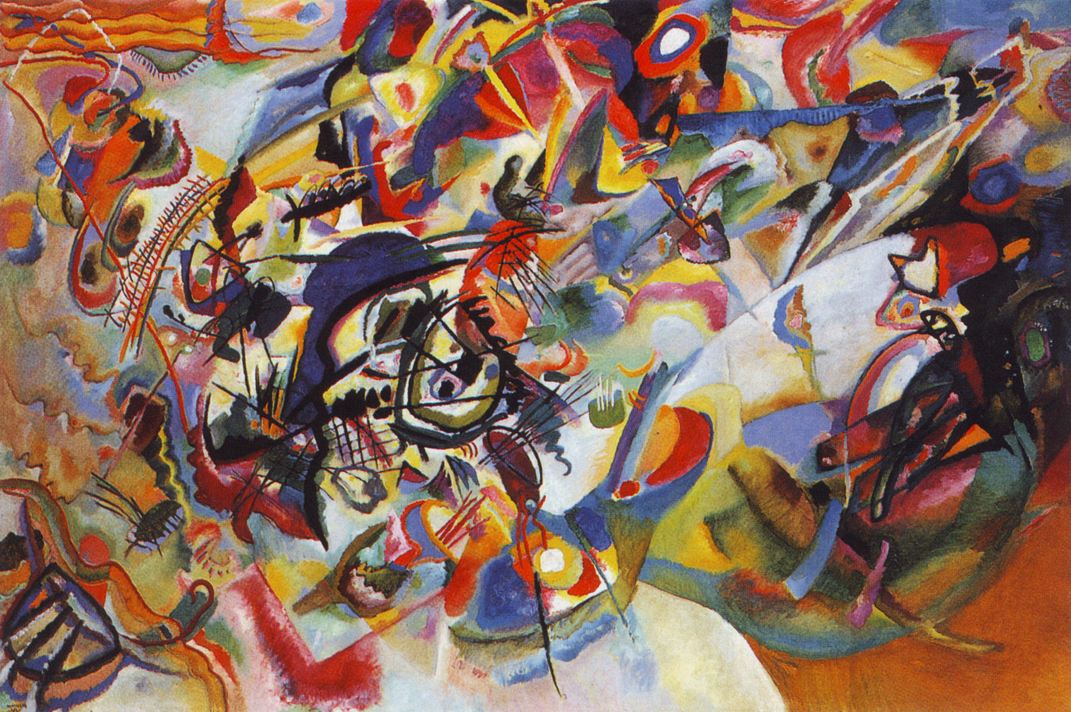Composition VII

Both of Kandinsky’s parents were musicians, and from a young age he learnt to play the piano as proficiently as they both did.
Soon, he had learnt the cello and rapidly began to read and comprehend music in its totality.
But his parents were to divorce while Kandinsky was still very young, and feeling unable to adequately care for their son, Kandinsky (1886- 1944) was sent to live with his aunt in Odessa.
During these early years, his love of art began to flourish – and he began working with watercolours.
Interest in music would later serve as a major inspiration, correlating closely to the themes of his artistic work; he linked many of his paintings to musical terms, naming them ‘Improvisations’ or ‘Compositions’.
Composition VII was painted in 1913, a work that would be considered the peak of his achievements before World War I.
Over thirty watercolour and oil sketches preceded the painting – a result of two months of preliminary work. Kandinsky made more studies for this work than for any other, and went on to describe it as the most complex of the series.
Once he had completed numerous weeks of preparatory work, Kandinsky created Composition VII in less than four days.
One of the drafts for Composition VII was signed and dated in 1910; it was considered by many art historians to be the first abstract painting in the history of art.
It was an early example of the synthesis he created between emotional, spiritual and non-referential art through patterns and colours.
Kandinsky could have been equally successful as an academic – before pursuing his artistic career, he had attended the University of Moscow in 1886 where he studied Economics, Law and Politics.
He was soon to have two life-changing encounters. Kandinsky attended a performance Wagner’s Lohengrin at the Bolshoi Theatre, and soon after was able to see the work of Claude Monet at a French Impressionist exhibition held in Moscow.
Monet’s Haystacks at Giverny captivated him immediately, particularly as he felt its loose abstraction seemed such a break from all previous art.
‘It was from the catalogue I learned this was a haystack. I was upset I had not recognised it. I also thought the painter had no right to paint in such an imprecise fashion.’
His transition to Munich was quite smooth – he had learnt German from his maternal grandmother as a child, and he was able to enrol at Munich Academy of Fine Arts.
He studied the ‘basics’ for an artistic education, taking courses in life study drawings, anatomy and sketching.
He began to grow frustrated that his powerful intellectual ability to comprehend the aesthetic principles of art seemed to somewhat exceed his own artistic abilities.
But slowly this frustration changed – Kandinsky began exploring his new ideas of painting and no longer felt constrained by the limitations of the art school’s teaching agenda.
As many of the courses were self-directed, he was able to incorporate his theories about the relationship between music and colour. Kandinsky used shades of colour like composers use musical notes – spacing them throughout his paintings to create a visual rhythm.
This musical inspiration led Kandinsky’s work further away from impressionism to purer abstraction.
He soon co-founded ‘Phalanx’, an artists’ association which opposed the conservative view of traditional art institutions, and decided to travel throughout Europe to familiarise himself with the growing Expressionist movement.
Kandinsky is considered by many observers to have had synaesthesia, a condition that allows a person to appreciate sounds, colours or words with two or more senses simultaneously.
In his particular circumstance, colours or painted brushstrokes triggered particular sounds for him.
Being an accomplished musician, he was able to explain; ‘Colour is the keyboard, the eyes are the harmonies, the soul is the piano with many strings. The artist is the hand that plays, touching one key or another, to cause vibrations in the soul.’
One inspired day when he entered his studio, he was struck by the beauty of a painting whose colours were highlighted by the rays of the sun. Getting closer he realised his picture was placed upside down.
At this moment, he understood that the subject matter of a picture could be eliminated in its totality, with the focus solely on the paint itself.
He quickly persuaded Franz Marc and other German artists he admired to form Der Blaue Reiter, the Blue Rider, an influential artist group that lasted until 1914, contributing importantly to the development of Expressionism.
The name of the group was attributed to Kandinsky’s love of blue and Marc’s love of horses.
During the outbreak of World War I, Kandinsky moved back to Russia where he worked for the Soviet government and their artistic campaigns, returning to Germany after the war and accepting a teaching position at the prestigious Bauhaus art school.
However as soon as the Nazi party came to power, the school closed and Kandinsky moved to Paris, living in a small apartment his friend Marcel Duchamp had found for him.
During the war years, it was hard to find canvases and other painting materials – the reason many of his late works were painted on wooden panels or boards.
Along with many of his fellow artists, the Nazis confiscated a number of his paintings, labelling them ‘degenerate art’. Kandisky painted until his last day in December 1944, dying at the age of seventy-eight.
During the last years of his life he would work mainly with more earthy tones, greys and browns – a significant change from the bold bright colours he was known for. As he pointed out: ‘Of all the arts, abstract painting is the most difficult. It demands that you know how to draw well, that you have a heightened sensitivity for composition and for colours, and that you be a true poet. This last is essential.’
